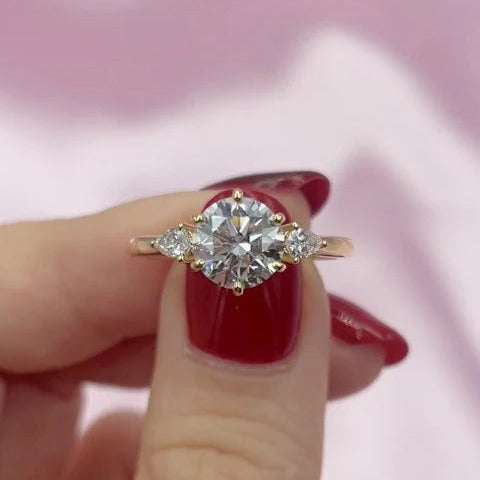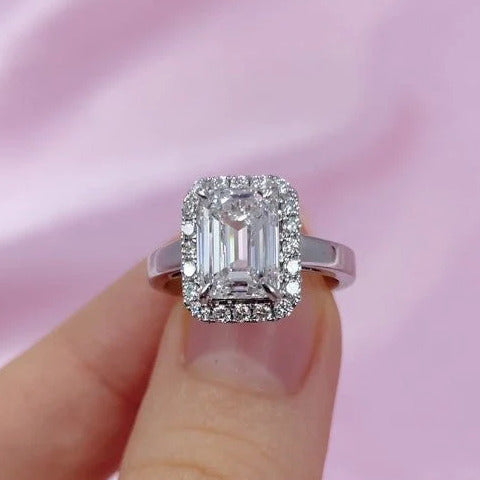The Ethical Proposal: Why Choose a Lab-Grown Diamond Engagement Ring

Table Of Content
The popular Chloe Lab-Grown Diamond Engagement Ring features a 0.77-carat center stone set in six prongs. This dainty ring is crafted from 18K gold and features a nature-inspired design with sparkling oval-cut lab-grown diamonds gracing its intricate details.
Love cannot be defined clearly with words. Though we can cite many sources that try to define love, one of the philosophers who closely approaches this is Fromm in his book “The Art of Loving.” He stated that “love is an active power in a man,” and the active aspect of love is “giving.”However, even Fromm cannot provide a precise definition of love.
Love is such a metaphysical term that symbolism is the only way to grasp its meaning. One of the quintessential symbols of romantic love is the ring, as exemplified by engagement and wedding rings. Being seen wearing one portrays an image of being committed to a lasting relationship.
Buy how did rings become synonymous with commitment and engagement? The first documented record of a diamond ring gifted in a proposal was in 1477, when Archduke Maximillian of Austria proposed to Mary of Burgundy, effectively making that the first engagement ring. The tradition caught on with the elites, presumably expressing love and commitment. As South African diamond mines began supplying the world with more diamonds, they became more widely available. The masses, or at least those who could afford it, adopted this tradition by the 19th century. It has been a symbol of commitment since.
“Diamonds Are Forever,” According to De Beers, That Is…
The inherent characteristics of diamonds make them perfect stones for engagement rings. They are, after all, the hardest naturally occurring substance on earth. Along with dazzling cuts mounted on exceptional jewelry designs led by Cartier and more affordable alternatives manufactured by Kay, diamonds reach more people than ever. The line “Diamonds Are Forever” is a marketing campaign that changed the industry. The line referred to both the physical longevity of diamonds and the fact that they retain their value. This perfectly fits the idea that a diamond engagement ring is a symbol of commitment, or a commitment to love, in its purest sense.
In recent times, however, people have begun to question diamond sources, entering the term “Blood Diamonds” into popular lexicography upon the release of the movie of the same name. Today, though the diamond industry passed the Kimberley Process to slow the proliferation of diamonds from suspect sources, there is a stigma among buyers, especially the younger market, in choosing natural diamonds.
Lab Grown Diamonds: An Ethical Way To Say I Do
The Shirley Round-cut Lab-Grown Diamond Engagement Ring features a 1-carat brilliant round-cut solitaire set in six prongs on a tapered ring design. Its timeless design is a classy expression of elegance and love.
Lab-grown diamonds are produced under simulated conditions that form natural diamonds. The two most economical methods of making lab-grown diamonds are high-pressure high temperature (HPHT) and chemical vapor deposition (CVD).
HPHT is an older method in which seed diamonds surrounded by pure carbon are placed in a growth chamber and subjected to a high-pressure and high-temperature environment for weeks until a gem is formed.
CVD is a recent method where pure carbon from methane broken down by ionization can merge with a heated diamond seed in a container. The entire process is conducted in a vacuum in a specifically designed machine.
Centuries of artisan perfected technique make pieces like the Charlize lab-grown diamond trilogy ring possible. Its 1.3-carat center stone flanked by 0.18-carat teardrop-shaped stones in intricate settings crafted in 18K gold makes a compelling and ethical choice.
Both methods produce stones physically and chemically identical to natural diamonds. Lab-grown diamonds possess the same hardness as natural diamonds. Granted, they have similar cuts and the same brilliance and fire. Even a trained jeweler must use specialized equipment to distinguish between natural and lab-grown diamonds.
Now manufactured in laboratories, lab-grown diamonds avoid the questionable sources found with “conflict diamonds.” Moreover, Singapore, where LeCaine sources its lab-grown diamonds, is at the forefront of cutting-edge lab-grown diamond production. They follow strict manufacturing and labor best practices, providing an added layer of assurance. Moreover, the efficiency of facilities producing lab-grown diamonds and their shorter supply chain make every gem result in a lower carbon footprint than its mined counterparts.
Beyond Ethics: More Value for Every Gem
The Emilia Lab-Grown Diamond Engagement Ring boasts a 2-carat E-color emerald-cut stone held by four claw prongs and surrounded by a dazzling octagonal halo of lab-grown diamonds combined in a vintage design. Lab-grown diamonds allow such an exceptional piece to include a gemstone of this size at a reasonable price point.
Since its introduction in the 1950s, lab-grown diamond manufacturing has experienced rapid improvement, resulting in its capability to produce larger gem sizes with superior clarity and color. Lab-grown diamonds available at LeCaine Gems have a clarity grade of VS-VVS1, which matches rarer natural diamonds, at sizes ranging from 0.2 carats for melee to 4 carats. The efficiency of the manufacturing process and its shorter supply chain also mean diamonds of exceptional quality are available at affordable prices.
Each lab-grown diamond that graces engagement rings from reputable jewelers like LeCaine Gems is IGI-certified, assuring buyers of their traceability and authenticity. The size, quality, and affordability allow jewelers to provide discerning buyers with engagement rings with exceptional designs and a flexible choice of gem sizes and colors, such as the Eartha Princess-Cut Lab-Grown Diamond Engagement Ring. This impressive piece features a 1.54-carat blue lab-grown diamond set in four prongs on a ring with a twisting nature-inspired design graced by dazzling lab-grown diamond accents.
Making the Right Choice Is up to You and Your Partner
Nowadays, gifting a loved one a diamond engagement ring transcends its initial purpose of expressing love and commitment. Today, choosing a precious piece of jewelry also reflects a commitment to ethical and sustainable practices. Because of their affordability, lab-grown diamond engagement rings are viable choices for couples with the same outlook on practicality.
When it comes to craftsmanship and quality, LeCaine Gems provides exceptional lab-grown diamond engagement rings. Their access to cutting-edge lab-grown diamond manufacturing facilities ensures that clients can choose the best possible engagement ring designs with a flexible range of diamond sizes at a reasonable budget. With lab-grown diamond engagement rings provided by LeCaine, you can have the ultimate expression of love and commitment while making an ethical and sustainable choice. With the same brilliance and quality as mined diamonds at an accessible price point, choosing a lab-grown diamond engagement ring speaks to your love, devotion, and values.
 Skip to main content
Skip to main content






